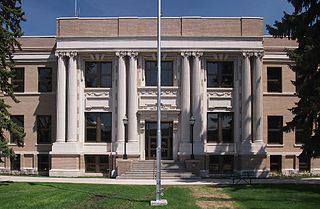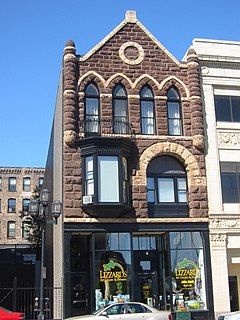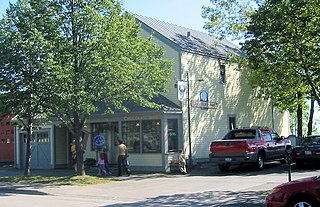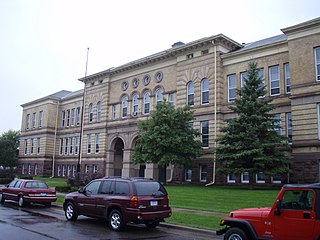
Endion station is a historic railroad depot in Duluth, Minnesota. The station was formerly located at the corner of South Street and 15th Avenue East, but due to the extension of Interstate 35 along the shore of Lake Superior in 1985, the building was relocated to the Canal Park area. It was listed on the National Register of Historic Places as the Endion Passenger Depot.

Merchants National Bank is a bank building in Winona, Minnesota, United States, designed in the Prairie School architectural style. It was built in 1912 and features elaborate terracotta and stained-glass ornamentation. It was listed on the National Register of Historic Places in 1974 for having state-level significance in the themes of architecture and commerce. It was nominated for being the "largest and probably best example" of the 18 Midwestern banks designed by Purcell, Feick & Elmslie, a significant influence on early-20th-century American architecture. It is also a contributing property to the Winona Commercial Historic District.

The Oliver G. Traphagen House, also known as Redstone, is a historic residential building in Duluth, Minnesota, United States. Built in 1892 as a duplex, it was designed and inhabited by architect Oliver G. Traphagen (1854–1932). The building was listed on the National Register of Historic Places in 1975 for its local significance in the theme of architecture. It was nominated for its association with Traphagen, recognized together with his business partner Francis W. Fitzpatrick as Duluth's leading architects of the late 19th century.

Sacred Heart Cathedral, Sacred Heart School and Christian Brothers Home comprise a former Roman Catholic diocesan complex in the Central Hillside neighborhood of Duluth, Minnesota, United States. Sacred Heart Cathedral was built from 1894 to 1896 and served as the seat of the Roman Catholic Diocese of Duluth until 1957, after which it became a parish church. Sacred Heart School was built in 1904 and the Christian Brothers Home—a monastic residence for the school faculty—was built in 1907.

Duluth Civic Center Historic District is a historic district in Duluth, Minnesota that includes four buildings: the Saint Louis County Courthouse, designed by architect Daniel Burnham and built in 1908–1909; Duluth City Hall, designed by Thomas J. Shefchik built in 1928, the Federal Building designed by government architects and built in 1920, and the Saint Louis County Jail built in 1924. The center is a notable work of the City Beautiful movement The complex is listed on the National Register of Historic Places.

The Alex Seitaniemi Housebarn is a rare surviving example of a log housebarn constructed by Finnish Americans, located in Waasa Township, Minnesota, United States. It was built in two stages from about 1907 to about 1913. The housebarn was listed on the National Register of Historic Places in 1990 for its national significance in the themes of architecture and European ethnic heritage. It was nominated for being an example of a rare building type and for embodying the settlement and traditional log architecture of rural St. Louis County's Finnish American farmers.

Munger Terrace is an architecturally significant rowhouse in the Central Hillside neighborhood of Duluth, Minnesota, United States. It was designed by Oliver G. Traphagen and Francis W. Fitzpatrick and built from 1891 to 1892, originally containing eight luxury townhomes. Munger Terrace was listed on the National Register of Historic Places in 1976 for its local significance in the theme of architecture. It was nominated for being Duluth's finest example of Châteauesque architecture applied to an apartment building.

The First National Bank of St. Cloud, Minnesota, United States, is a historic bank building constructed in 1889 and doubled in size around 1918. It was designed by architect Charles Sumner Sedgwick for St. Cloud's first bank, which was established in 1867 and chartered as a national bank in 1882. The building was listed on the National Register of Historic Places in 1982 for its local significance in the themes of architecture and commerce. It was nominated for being St. Cloud's "finest designed and best preserved commercial building"—in the words of historian Thomas Harvey—and for its important financial role in the development of St. Cloud and surrounding Stearns County.

The Church of St. Bridget is a Roman Catholic church in De Graff, Minnesota, United States. The parish, founded in 1876, was the first established in a major drive by Archbishop John Ireland to settle western Minnesota with Catholics. Its current building was constructed in 1901 and was listed on the National Register of Historic Places in 1985 for having local significance in the themes of architecture, community planning and development, exploration/settlement, and religion. It was nominated for its association with the beginning of Archbishop Ireland's colonization effort, the influence of the Catholic church on De Graff's development and population, and for being a rare outstate church building designed by Saint Paul architect Edward J. Donahue.

The Church of St. Francis Xavier is a Roman Catholic church in Benson, Minnesota, United States. The parish was founded in 1881 and its current building was designed by architect Emmanuel Louis Masqueray and constructed in 1917. St. Francis's building was listed on the National Register of Historic Places in 1985 for having local significance in the themes of architecture and European ethnic heritage. It was nominated for being one of west-central Minnesota's most architecturally sophisticated churches, for its Renaissance Revival design by Masqueray, and for its association with a parish of Swift County's late-19th-century Catholic settlers.

The Duluth Public Library is a former Carnegie library at 101 West Second Street in Duluth, Minnesota, which is listed on the National Register of Historic Places. It opened in 1902 and operated as a library through 1980.

The St. Louis County District Courthouse is the seat of government for the northern district of St. Louis County, Minnesota, United States, located in the city of Virginia. The St. Louis County District Court is held in three locations, in Duluth, Hibbing, and Virginia.

The Wirth Building is a commercial building in downtown Duluth, Minnesota, United States. When it was constructed in 1886 it was the city's first example of Richardsonian Romanesque style, and it stands as an early work of architect Oliver G. Traphagen. The Wirth Building was listed on the National Register of Historic Places in 1991 for its local significance in the theme of architecture. It was nominated for being a leading local example of its architectural style and a key turning point in the career of an important Duluth-based architect.

The Lester River Fish Hatchery was a federal fish hatchery in Duluth, Minnesota, United States. It was built at the mouth of the Lester River in the 1880s to propagate fish for the Lake Superior commercial fishery. The hatchery closed in 1946 and the facility was sold to the University of Minnesota Duluth, which used it as its Limnological Research Station. The surviving four buildings are noted for their Stick and Shingle Style architecture, forming a distinctive landmark to local residents as well as tourists heading to Superior's North Shore.

The Bergetta Moe Bakery is a historic commercial building in Duluth, Minnesota, United States. Constructed around 1875, it is one of Duluth's oldest standing buildings. It was listed on the National Register of Historic Places in 1976 for its local significance in the theme of architecture. It was nominated for exemplifying the simple wood-frame, gabled style that characterized Duluth's first-generation architecture.

Irving School is a former school building in Duluth, Minnesota, United States. It operated as a school from its construction in 1895 until 1982, when it was closed due to declining enrollment. Upon closing it underwent adaptive reuse as an apartment building. In 1992 the Irving School was listed on the National Register of Historic Places for its local significance in the themes of architecture and education. It was nominated for its early Renaissance Revival design by Palmer, Hall, & Hunt and for its association with the expansion and evolution of the Duluth school system.

Endion School is a former school building in the East End/Endion neighborhood of Duluth, Minnesota, United States. Built in ornate Richardsonian Romanesque style with a unique design on a prominent hilltop site, it has been a local landmark since its construction in 1890. Endion School was listed on the National Register of Historic Places in 1983 for its local significance in the theme of architecture. It was nominated as the finest surviving example of Duluth's Late Victorian school buildings.



























